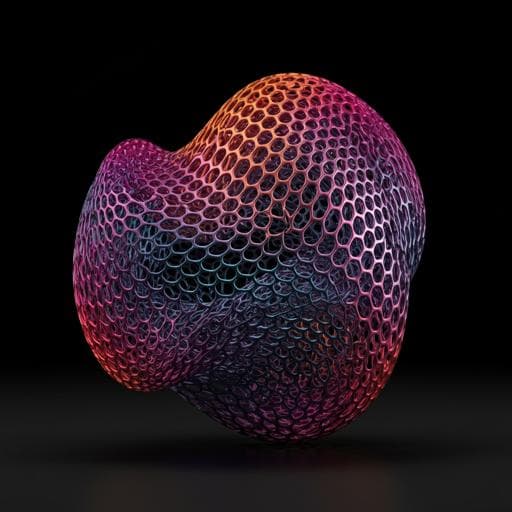
Engineering and Technology
Rapid inverse design of metamaterials based on prescribed mechanical behavior through machine learning
C. S. Ha, D. Yao, et al.
This groundbreaking research conducted by Chan Soo Ha, Desheng Yao, Zhenpeng Xu, Chenang Liu, Han Liu, Daniel Elkins, Matthew Kile, Vikram Deshpande, Zhenyu Kong, Mathieu Bauchy, and Xiaoyu (Rayne) Zheng reveals a rapid inverse design methodology leveraging generative machine learning and desktop additive manufacturing. It allows for the creation of metamaterials with customizable mechanical properties, achieving an impressive 90% fidelity in stress-strain curve performance.
~3 min • Beginner • English
Introduction
The study addresses the challenge of inverse designing architected metamaterials to reproduce prescribed mechanical behaviors, expressed as uniaxial compressive stress-strain curves. Conventional bulk materials have limited tunability of mechanical response since behavior is governed by intrinsic microstructure and defects. Additive manufacturing (AM) enables tailoring via micro-architecture, yielding unusual properties (e.g., negative Poisson’s ratio, negative compressibility, ultralightness, multistability). Existing forward design, topology optimization, and ML approaches can target specific properties but often fail to capture full stress-strain behavior due to non-unique mappings, nonlinearities, and the impact of manufacturing defects and variability. The paper proposes a rapid inverse design framework using generative machine learning combined with desktop 3D printing to directly generate lattice designs that reproduce target stress-strain curves—monotonic or cyclic—while accounting for process-dependent errors, thus reducing iteration and designer expertise requirements.
Literature Review
The paper situates its contribution within work on architected materials designed by forward methods, topology optimization, and ML. Prior approaches have achieved unusual properties and expanded Ashby chart regions, but are limited by many-to-one mapping between architectures and responses, computational cost, and sensitivity to AM-induced defects (anisotropy, porosity, dimensional errors) leading to performance deviations. References include foundational works on negative Poisson’s ratio and other metamaterial properties, topology optimization for multifunctional designs, and recent ML-driven metamaterial design and inverse design attempts. The authors underscore the need for methods that encode process variability and nonlinearity, bridging design intent (full curve shapes) and printed performance without extensive calibration.
Methodology
- ML pipeline: A generative ML framework with two modules: (i) inverse prediction and (ii) forward validation, each comprising five neural network (NN) models. The inverse module predicts candidate design parameters {Y} from target curve features {X†}, while the forward module predicts curve type and curve features for given {Y}. Five candidate designs are generated; the forward module evaluates each, and the optimal design is selected by minimizing a feature-based cost function between predicted and target curve features, addressing one-to-many mapping.
- Design space and inputs: A dimensionless design space spans nearly all feasible compressive stress-strain behaviors for cellular materials. Axes: strain ε and normalized compressive strength σ/σys. Subspaces are bounded by elastic stiffness and yield strength limits for isotropic polymers and an approximate failure bound. Target curves are user-constructed from control points: origin to linear-elastic limit, followed by peaks/valleys, and an endpoint, for monotonic or cyclic loading. Features include control points, load type, strain energy, slopes between points, yielding 46 input features {X}.
- Architectural unit cells: A family of cubic-symmetric strut-based cells parameterized by: cell type Tcell (Y1), characteristic angle φ (Y2), and radius-to-length ratio of inclined struts r1/L1 (Y3). Varying φ and r1/L1 tunes deformation mechanisms (buckling, snapping, yielding) and thus curve shapes. Cubic symmetry ensures direction-invariant behavior and straightforward tessellation, enabling compound lattices.
- Dataset generation (uniform lattices): φ and r1/L1 were discretized to create hundreds of architectures. Lattices (20×20×20 mm³, two unit cells per direction) were printed via digital light stereolithography in a brittle polymer (TMPTA). Three samples per design were tested under monotonic and cyclic compression. Measured curves were parameterized into 46 features and paired with {Y}, yielding 1212 X–Y pairs (pristine). Data augmentation expanded to 9360 pairs to stabilize many-to-one mappings and capture experimental variability.
- Training strategy: The forward module (curve-type classifier and feature regressor) was trained first on the augmented dataset as a fast surrogate (seconds vs hours for FEM). It was then frozen and used to train the inverse module on the pristine dataset using a feature-space loss f(X, X′) to prevent collapse of {Y} into a latent code. Cross-validation (typical 70/30 and 10-fold) showed ~90% prediction accuracy and stable learning without over/underfitting.
- Compound lattices: To enable advanced curve features (variable tangent modulus, multiple peaks/valleys), compound lattices with spatial gradients were introduced and simulated via FE using a flexible polymer model. Gradient labels describe spatial variation: G1 (unit cell type gradient), G2 (strut radius ratio gradient), G3 (inclined strut radius gradient), G4 (cell size gradient). A sequential integration strategy predicts gradients in order: C1(X)→G1; R1(X,G1)→G2; R2(X,G1,G2)→G3; C2(X,G1,G2,G3)→G4.
- Experiments and simulations: Quasistatic compression on printed samples (Instron 5944) at 10⁻³ s⁻¹; cyclic tests at multiple strain levels. Drop tests for energy absorption on selected compound lattices. FE simulations in ABAQUS with beam or tetrahedral elements depending on relative density, explicit quasi-static solver, contact/friction, and calibrated polymer material models verified by tensile tests.
Key Findings
- Inverse design success across diverse curve types: The method reproduced representative target stress-strain paths under monotonic and cyclic compression, including negative stiffness (buckling), strain hardening, plateau regions, brittle fracture, and snap-through responses. For each case, among 10 prints, the best measured curve closely matched the target with low normalized RMSE (values near 0 reported in Fig. 3a), and uncertainty bands captured process variability.
- Accuracy and speed: Overall prediction accuracy ~90% in cross-validation; forward surrogate evaluates designs in seconds vs hours for conventional simulations; inverse pipeline outputs printable 3D models in seconds on a desktop.
- Robustness to process variability: Increasing process variability by ~2.6× (comparable to selective laser sintering) reduced prediction accuracy by ~7%, still yielding acceptable uncertainty regions.
- Tailored consumer application: A four-zone shoe midsole was inversely designed by tailoring measured baseline curves to improve propulsion/cushioning. Printed sections achieved >90% average prediction accuracy between target and experimental curves, including scaling for dynamic responses from quasistatic data.
- Compound lattices enable advanced features: Gradient-based designs independently modulate tangent modulus sign/magnitude and multiple peak stresses. Empirical relationships observed: tangent modulus mainly controlled by G3 (inclined strut radius) and G4 (cell size); first peak stress by G1 (cell type) and G2 (strut radius ratio); second peak stress strongly influenced by G2.
- Energy absorption performance: A compound lattice designed for stepwise energy absorption reduced measured impact acceleration by ~30% and potential energy by ~25% in drop tests. In a normalized energy absorption vs transmitted strength map, performance surpassed previously reported lattice materials.
Discussion
The results demonstrate that a generative ML pipeline can reliably map full prescribed compressive stress-strain behaviors to manufacturable lattice architectures while inherently accounting for printing-induced variability learned from experimental data. By selecting optimal designs via forward-validated feature comparisons, the approach resolves the non-uniqueness of inverse mappings. The capability to tailor entire curve shapes, not just scalar properties, enables multifunctional, spatially varying components (e.g., midsoles) and advanced hysteresis/energy absorption profiles (via compound lattices). The method substantially reduces design-manufacture-test iteration time by replacing expensive simulations with a trained surrogate and by learning process errors directly. Beyond compression, the stress–response curve formalism and pipeline can be adapted to other load cases (tension, bending, shear) and even other physical domains (acoustic, magnetic, electromechanical) when behaviors are representable as response curves. The findings thus advance rapid, data-driven inverse design toward practical, customizable metamaterial products.
Conclusion
The paper introduces a rapid, ML-driven inverse design methodology that generates 3D-printable metamaterial architectures to reproduce prescribed compressive stress-strain curves with high fidelity (~90%) while incorporating process variability. It validates inverse designs across diverse behaviors, demonstrates a multi-zone tailored shoe midsole, and extends capability via compound lattices to achieve advanced curve features and superior energy absorption. The approach dramatically shortens evaluation time and reduces the need for iterative prototyping. Future work includes expanding datasets and transfer learning to other AM processes (e.g., metals), incorporating processing parameters and material anisotropy/property evolution, and generalizing to additional mechanical load cases and other response-curve-governed physical behaviors.
Limitations
- Scope limited to compressive behavior; other load modes require additional training datasets.
- Training and most experiments conducted with polymer-based stereolithography, which has relatively low variability; applicability to processes with higher variability (e.g., metal AM) may require more data or transfer learning.
- Current models do not explicitly encode manufacturing-induced anisotropy, porosity, shrinkage, or microstructural evolution common in metals; property evolution and anisotropy effects were not included as features.
- Dataset size, material diversity, and printer/process parameter coverage constrain generalizability; increased variability reduces accuracy (~7% drop for ~2.6× variability increase).
- Surrogate fidelity is tied to the training distribution; extreme designs outside the explored design space may yield larger errors.
Related Publications
Explore these studies to deepen your understanding of the subject.







